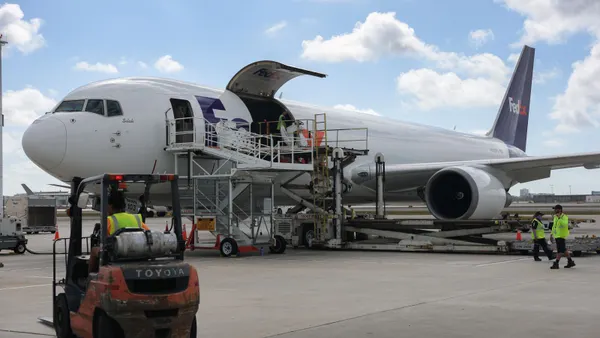Dive Brief:
- United Airlines placed a greater focus on cargo in the second quarter as it tried to offset declines in passenger revenues, executives from the airline said on an earnings call this week.
- "We also operated over 3,800 old cargo charted flights in the quarter, which contributed to our over 36% improvement in cargo revenue in the quarter, while our competitors saw cargo revenue decline," United Airlines Chief Commercial Officer Andrew Nocella said on the call. American Airlines and Delta Air Lines posted double-digit declines in cargo revenue in their recent earnings, down 41% and 42%, respectively.
- The airline expects cargo revenue to improve year over year in the third quarter too, but it is too early to tell it if will be to the level of the second quarter, Nocella said.
Dive Insight:
Cargo is not usually the main moneymaker for airlines, but the belly capacity in passenger airlines serves as an important link in the global supply chain. When airlines cut passenger capacity, that resulted in cuts to cargo capacity, and airfreight rates for shippers increased.
Airline associations including The International Air Transport Association (IATA) and Airlines for America have been pushing for governments to ease cargo regulations to allow passenger airlines to carry more freight in the passenger section of the aircraft and boost overall capacity for air shippers. The Federal Aviation Administration has provided guidance on how the airlines can carry cargo in seats or remove seats entirely to make way for cargo on passenger planes.
American Airlines has expanded its cargo service to transport "critical goods" between the United States and Europe, Asia and Latin America, the airline said in its earnings release. American said it is currently operating more than 310 weekly widebody and cargo-only flights and has transported more than 100 million pounds of mail, goods and supplies in the second quarter.
United said it operated 3,800 cargo-only flights to transport 204 million pounds of cargo during the second quarter.
"Dedicated freighter capacity remains elevated, while belly cargo capacity (incl. freighters) is slowly rising on the back of a slow return to passenger operations on some international markets," IATA said in a research note earlier this month. "However, the capacity crunch is likely to take some time to unwind as the passenger fleet returns to service at a gradual pace."
And as the capacity crunch continues, airfreight rates remain high. Rates are now lower than their peak in May, but still elevated compared to before the pandemic, according to the TAC Index.
United Airlines said it does not expect the global fleet of wide-body planes to fly as they normally would during the third quarter, continuing the trend seen throughout the pandemic.
"Cargo revenue does come in rather close to departure time," Nocella said. "So it's a little bit more difficult to predict, but we expect it to have another great quarter."














